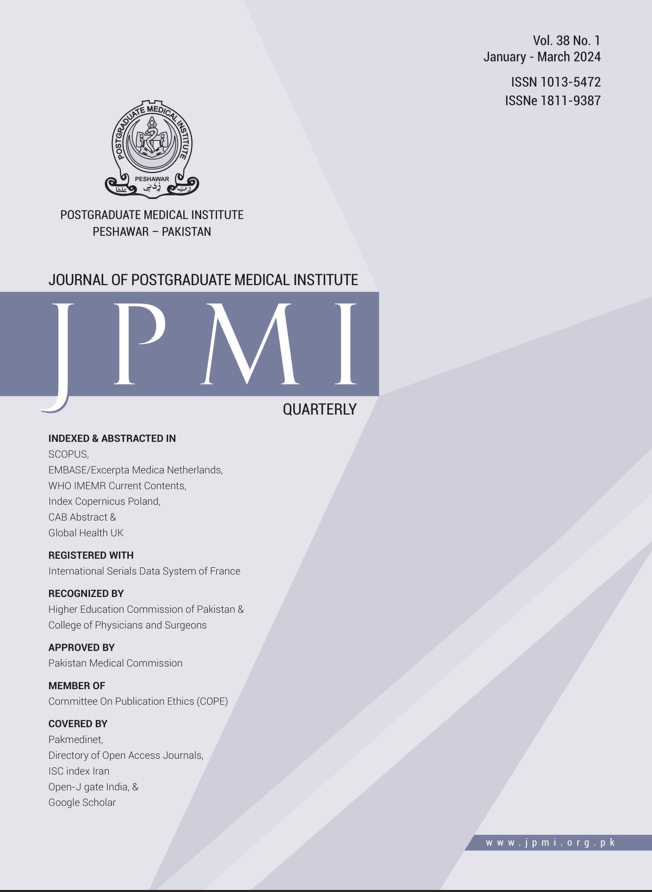EFFECTIVENESS OF OREM SELF-CARE THEORY INTERVENTION FOR IMPROVEMENT IN SELF-CARE PRACTICES AMONG MYOCARDIAL INFARCTION PATIENTS; A QUASI-EXPERIMENTAL STUDY
Main Article Content
Abstract
Objective: The aim of the study was to identify the effectiveness of Orem self-care theory for the improvement of self-care practices among myocardial infarction patients to fill research gap in context of Pakistan.
Methodology: The study design was quasi-experimental. The study was conducted between June and September 2022 having a sample size of 90 patients. The study instrument was a self-structured reliable questionnaire of self-care practices that was filled out before intervention and 12 weeks after the intervention, while the intervention was 2 sessions of one hour.
Results: In the study, the number of total participants was 90 divided into experimental (n=45) and control group (n=45). In the experimental group majority of the participants were females (51.2%) having a mean score of (61.5 ± 5.5), while in the control group the number of male participants was in majority (57.8%) while the mean score was (61.3 ± 5.1). In experimental group the intervention was effective on physical (p=0.001), psychological (p=0.000), emotional (p=0.009), and spiritual (p=0.003) self-care. While there is no effect seen on workplace and relationship care.
Conclusion: The overall self-care of the experimental group was significantly positively changed compared to the control group that concludes that the intervention was effective.
Article Details
Work published in JPMI is licensed under a
Creative Commons Attribution-NonCommercial 2.0 Generic License.
Authors are permitted and encouraged to post their work online (e.g., in institutional repositories or on their website) prior to and during the submission process, as it can lead to productive exchanges, as well as earlier and greater citation of published work.
References
Rayan RA, Sharma S. Lomitapide-StatPearls-NCBI Bookshelf. National Center for Biotechnology Information. Citované. 2022;17:560849.
Nascimento BR, Brant LCC, Marino BCA, Passaglia LG, Ribeiro ALP. Implementing myocardial infarction systems of care in low/middle-income countries. Heart. 2019;105(1):20-26.
Ramachandra CJ, Hernandez-Resendiz S, Crespo-Avilan GE, Lin YH, Hausenloy DJ. Mitochondria in acute myocardial infarction and cardioprotection. Ebio Med. 2020;57:102884. DOI: :10.1016/j.ebi-om.2020.102884.
Cardiovascular diseases (cvds). World Health Organization. World Health Organization; 2021.
Berg DD, Wiviott SD, Braunwald E, Guo J, Im K, Kashani A, Gibson CM, Cannon CP, Morrow DA, Bhatt DL, Mega JL, O'Donoghue ML, Antman EM, Newby LK, Sabatine MS, Giugliano RP. Modes and timing of death in 66 252 patients with non-ST-segment elevation acute coronary syndromes enrolled in 14 TIMI trials. Eur Heart J. 2018;39(42):3810- 20. DOI: 10.1093/eurheartj/ehy556.
Mechanic OJ, Gavin M, Grossman SA, Ziegler K. Acute Myocardial Infarction (Nursing). InStatPearls. 2021. StatPearls Publishing.
Lu L, Liu M, Sun R, Zheng Y, Zhang P. Myocardial infarction: symptoms and treatments. Cell Biochem Biophys. 2015;72(3):865-7.
Dhanya A, Agarwal P, Dhandapani M, Mahendra J, Gopichandran L. Comparison of Clinical presentation of Acute Coronary Syndrome in Diabetic Vs Non-diabetic patients. Asia J Nurs Educ Res. 2019;9(1):102-8. DOI: 10.5958/2349-2996.2019.00020.X.
Bhatti MW. 46 people dying of heart diseases in Pakistan every hour. The News. 2018.
Jung HG, Yang YK. Factors influencing health behavior practice in patients with coronary artery diseases. Health Qual Life Out. 2021;19(1):1-9. DOI: 10.1186/s12955-020-01635-2.
Yang YK. Factors infuencing preventive health behaviors for cancer in undergraduates. J Korean Acad Fundam Nurs. 2015;22(1):59–68 DOI: 10.7739/jkafn.2015.22.1.59.
Mohammadpour A, Rahmati Sharghi N, Khosravan S, Alami A, Akhond M. The effect of a supportive educational intervention developed based on the Orems self care theory on the self care ability of patients with myocardial infarction: A randomised controlled trial. J Clin Nurs. 2015;24(11-12):1686-92. DOI: 10.1111/jocn.12775.
Olivella Fernandez MC, Bastidas Sanchez CV, Castiblanco-Amaya MA. Adherence to self-care among persons with cardiovascular disease: an approach based on the orem model of nursing. Aquichan. 2012;12(1):53-61.
Ali BH. Application of Orem self care deficit theory on psychiatric patient. Ann Nurs Prac. 2018;5(1):1-3.
Campbell N, Ritchie L, Thain J, Deans H, Rawles J, Squair J. Secondary prevention in coronary heart disease: a randomised trial of nurse led clinics in primary care. Heart. 1998;80(5):447.
Erdfelder E, Faul F, Buchner A. GPOWER: A general power analysis program. Beh Res Meth Instr Comp. 1996;28:1- 1.
Saakvitne KW, Pearlman LA. Transforming the pain: A workbook on vicarious traumatization. WW Norton & Co; 1996. Modified by SCU CAPS 8/23/12
Lovlien M, Schei B, Hole T. Myocardial infarction: psychosocial aspects, gender differences and impact on pre hospital delay. J Adv Nurs. 2008;63(2):148-54.
Kristofferzon ML, Lofmark R, Carlsson M. Striving for balance in daily life: experiences of Swedish women and men shortly after a myocardial infarction. J clin Nurs. 2007;16(2):391-401. DOI: 10.1111/j.1365-2702.2005.01518.x.
Yildiz FT, Kasikci M. Impact of training based on orem's theory on self care agency and quality of life in patients with coronary artery disease. J Nurs Res. 2020;28(6):e125. DOI: 10.1097/ JNR.0000000000000406.
Khatiban M, Shirani F, Oshvandi K, Soltanian AR, Ebrahimian R. Orem’s self care model with trauma pa-tients: a quasi-experimental study. Nurs Sci Q. 2018;31(3):272-8. DOI: 10.1177/0894318418774.
Malekzadeh J, Amouzeshi Z, Mazlom SR. A quasi experimental study of the effect of teaching Orem's self care model on nursing students’ clinical performance and patient satisfaction. Nursing Open. 2018;5(3):370-5. DOI: 10.1002/nop2.151


